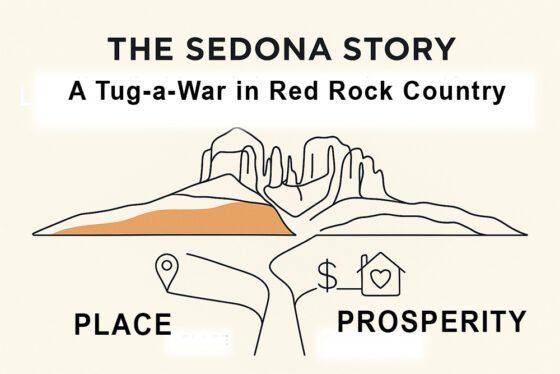Essay by Bear Howard and Associates

On most mornings in Sedona, the rock faces light up like lanterns—Cathedral Rock, then Bell Rock, then the long sandstone walls that glow like a stove coming to heat. It’s a show you can set your watch by. About three million people a year try to catch it. Fewer than ten thousand live there full-time. That gap—visitors outnumbering residents by hundreds to one—explains a lot of what’s wonderful about Sedona, and much of what’s hard.
In some ways, Sedona is a microcosm of the American world at large, the world challenged by change, the popularity of tourism, and local movements to challenge their governments and the decisions they make.
To hear narration click below:
Sedona is both a destination and a promise: a long weekend with big skies, a spiritual pit stop, a place to reboot your life at 39 or 59 years of age. It is also a city that funds itself in a very specific way. There’s no local property tax. City services—police, parks, road paint, new sidewalks and roads—run mostly on sales and lodging taxes.
The locals, who benefit from city services and the hundreds of businesses that rely almost totally on tourism spending, such as restaurants, supermarkets, nightclubs, our galleries, etc., actually contribute very little to the overall funding since a sales tax of 3.5% on “local” purchases would barely cover the cost of running a town of just a few thousand people.
In a good year, the 3.5% “bed tax” on hotel and short-term stays and the additional 3.5% sales tax help keep the shuttle buses moving and the city managing its hundred million dollar budget.
What follows is an attempt to tell the human story behind those facts: the visitors who arrive, the residents who stay (or leave), the business owners who welcome and worry, and the public servants caught in the crossfire.
People come for the landscape, and many decide to stay for the lifestyle. The median age is near sixty, which tells you something about who’s arriving and what they seek: views, wellness, time. The visitor economy sits on that same foundation—trailheads with names that sound like invitations, spas that promise renewal, and a wellness scene that turned “vortex” from local legend into business plan.
The city has leaned into basic management instead of magical thinking. The Sedona Shuttle, a free bus to major trailheads, passed its one-millionth rider in March 2025. When the shuttle runs, the lots at those trailheads are closed to private cars. It’s a simple nudge that works: fewer cars stacked on narrow roads, fewer boot-to-bumper scenes at dawn. The “Sedona Cares” pledge—friendly reminders like “If I can’t find a parking spot, I won’t invent my own”—makes the rules feel neighborly instead of scolding.
Still, the tradeoff is real. Visitors leave after three or four days with sunset photos. Residents who live with those sunsets also live with the lines they create. The friction is not only about traffic. It’s about who pays to keep a complicated, beautiful place running—and who gets to stay.
If you work in Sedona, odds are you don’t sleep there. A 2022 brief from ASU’s Morrison Institute found that only about a quarter of local workers actually live in the city. The rest drive from the Verde Valley or farther. Housing supply is tight, prices are high, and demand for “workforce” homes outruns what a small city can build on its own.
Into that mix, Arizona’s Senate Bill 1350 arrived in 2016 and limited local control over short-term rentals. Investors noticed. In Sedona, listings multiplied—from roughly 400 to more than 1,200 by late 2024, many of them whole homes with seven-figure price tags.
The city declared a housing emergency. Teachers and service staff were squeezed out. Long-term rentals turned into mini-hotels. Real-estate groups tout the spending visitors bring; city reports document the strain on neighborhoods and the workforce. Both claims can be true. On the ground, they share a fence line. Its school district has almost been cut in half since the mid-2010s as families with children left.
When the city proposed a modest fix—a “Safe Place to Park” where local “workers” sleeping in cars could park legally, with bathrooms and showers—Sedona split. The council approved the temporary two-year zoning in March 2024. By November, voters said no.
National outlets framed it as an affluent town choosing what it wanted to see inside its borders and the “type” of people they were willing to accept as residents, even if only overnight. Locally, it felt more personal: a fight over dignity, safety, and who counts as a neighbor.
Think of Sedona, financially, like a factory town whose factory is hospitality. With no property tax, everyday services depend on what visitors buy and where they sleep. City staff try to make that math transparent. The Chamber repeats it often: there’s no grocery tax, and tourists help underwrite services and businesses residents use daily.
That arrangement leads to a standing argument about identity. For business owners, Sedona is a hospitality engine with a culture on top. For many residents, it’s a small town with an outsized backdrop that shouldn’t have to perform for the world at all hours. City staff work where those views collide, running a high-complexity operation on a tax base built around people, many of whom leave on Monday.
Sedona has become very good at public argument. The meetings are full, the emails are long, and the Facebook/Nextdoor threads never sleep. Recent chapters are familiar to many American towns, just dialed up:
Short-term rentals remain the biggest pressure point. The state set the rules; the city pushes every lever it can—licensing, enforcement, lobbying—while residents trade before-and-after photos of streets turning into hotel rows.
The Cultural Park, a defunct amphitheater site, has turned into a blank canvas for competing futures. Some want preservation. Others see a chance for housing near jobs and services. A possible Citizen “initiative” will try to settle the question at the ballot box in 2026, but each campaign becomes a referendum on what and who Sedona is for.
“Safe Place to Park” drew a clean line through the city. Supporters saw a humane, temporary fix; opponents feared a magnet for problems. The vote settled the program for now, but not the need.
ALPR cameras—automated license plate readers—sparked a local version of a national debate. Supporters call them a basic policing tool used in many cities to flag stolen cars or wanted plates. Critics see a step toward constant surveillance. By mid-August 2025, the council told staff to shut them off while the city rethinks. Big words for a small number of devices, and another example of how quickly tools become symbols.
What these fights share is not a lack of facts but a clash of priorities. People moved to Sedona, in part, to escape tradeoffs. City life brings them back. Fighting change, even change that seems to be positive, has become a religious-like zeal. Some people yearn for a Sedona of the past, while others yearn for a Sedona they imagined in their dreams before they called the place home.
Ask a visitor flying or driving home on Sunday, and you will hear about color and air and the laugh-out-loud beauty of a first hike. The new shuttle system and clear trail rules help the city deliver on that promise.
Ask a resident five years in, and it gets more complicated. Many will say Sedona changed their life: a trail before breakfast, a dog-walk in postcard light, the pleasure of a city that still feels like a town. Others will talk about costs: a housing market that behaves like a stock chart, a workforce commuting from Cottonwood or Camp Verde, a “busy season” that never seems to end.
For some, Sedona becomes a bright chapter before a saner mortgage, and a bigger supermarket call from down the hill. (Down the hill is Phoenix, home to 5+ million who head uphill to Sedona, the Verde Valley, and Flagstaff to escape the heat and “city life.”)
This is not a policy memo, but some plain ideas keep showing up. There are ways to improve the overall lifestyle of residents at the same time, while maintaining the attraction of one of the most beautiful places on earth.
First, be honest about the ledger. A city built on sales and lodging taxes can’t wish tourism away without replacing that income or trimming services. That does not mean “anything goes.” It does mean any plan for “less” needs a plan for “how.”
And if “less” means fewer tourists, that means “less” revenue to run the town, and “less” revenue, perhaps enough to close some businesses like the town’s coveted Whole Foods Market or six-screen movie theater.
A town of 9,600 people would never have four major supermarkets, upwards of 50 different kinds of eating establishments, two different movie theater operations, a major office supply store, and hundreds of retail establishments. Without a robust tourism environment, everybody knows Sedona would be a sleepy town in the high desert with pretty red rocks!
Second, think regionally because the region already does. Workers, shoppers, and renters cross city lines every day. Shared housing goals, better transit across the Verde Valley, and cooperative land-use deals spread the load and the benefits.
Third, manage the peaks. Stewardship pledges and smart demand control—like closing parking lots when shuttles run—aren’t culture wars. They’re crowd control and safety, the civic version of opening extra gates after a Friday-night game.
Fourth, tell the whole truth about short-term rentals. They bring money, and they displace neighbors. State law is the main player. Until it changes, cities can license, enforce, and measure the impact clearly enough that lawmakers have to listen.
And until then, everybody just has to accept that residential zoning no longer means “residents and neighborhoods” and owning an extra home is a new form of a side hustle for investors and enterprising residents.
Finally, stop turning every tool into a test of the town’s soul. A dozen cameras aren’t the end of liberty, and a shuttle bus isn’t a threat to freedom. They’re tools. Debate scope and safeguards, not grand theories. Staff need room to do their jobs; councils need steadiness; the public needs fewer bonfires.
Summary:
It would be tidy to say Sedona must choose: retreat into a protected sanctuary for the lucky few or become a well-run theme park that funds itself. Real life isn’t tidy. Sedona has to be both—a hometown and a destination—because the lights at City Hall and the quiet at sunrise come from the same system.
In the red glow of a summer morning, the place feels whole again. Visitors line up the shot. Residents walk the dog before the day gets loud. Soon the lots will fill, the shuttle will hum, the council will gavel in, and someone’s post will relight an old argument. For a moment, though, Sedona is simply a city that sells awe to pay for ordinary life. That’s not a scandal. It’s a kind of grace.
Sedona is known throughout the world and will continue to attract millions of visitors for the foreseeable future. It has become a Mecca for so many looking for a special moment in their lives. In many ways, the residents are the stewards of this land, but they do not have the right or the ability to close the door to a place that is owned by the world. They are the lucky few who have chosen this piece of heaven as their home.
Bottom line: Sedona means different things to different people—that’s its magnetism and its management challenge. For most visitors, it’s a destination where landscape, meaning, and wellness overlap. For many residents, it’s a stage of life—bright, sometimes brief—set inside a regional economy that doesn’t stop at the city limits. The work ahead is simple to say and hard to do: keep the promise of awe while tending a livable hometown.






1 Comment
Great analysis of small town USA Mr Bear.
Go to any small town in the country and you will see and hear the same things: “I don’t want to see expansion or progress I want things how they were in the 70’s or prior”. That’s an impossible dream! The US and worlds population ms have grown and with population growth comes the need for expansion. How that expansion is done is another question. Nobody wants a bunch of like businesses especially resorts encroaching upon our properties or natural environment where people go to clear their heads. Nobody wants heavy traffic nor throngs of visitors trampling on any and everything we as residents cherish. And yet that’s the fate Sedona decided for itself.
Many a small town in Europe have faced the exact same problems we have. Swiss farmers pissed of over tourist trampling their delicate and critically important crops have begun installing turnstiles to their properties and charging tourists to travel a designated pathway through their properties. The Spanish shoot tourists with water guns out of disdain for what they represent. The Italians have had to create new local ordinances regarding acceptable public appearances as many a tourist think it perfectly normal to come off the beaches naked or topless and waltz around town naked and topless.
Search and Rescue teams worldwide have been inundated by tourists who venture out onto the trails ill prepared, wearing flip flops or even going barefoot in rough terrain. Fortunately unlike here in AZ most other countries not only fully charge for rescues they also require pre paid life insurance and burial fees as well as a required user fee and registration to use their trails so they know who is on them and can pay for damages done by tourist ignorance such as littering and graffiti. Canada recently closed trails in BC because of the extreme fire hazards they have been faced with the past couple of years. Imagine the outrage if Sedona City Government enforced a similar policy due to fire hazards. People feel it their right to do whatever the hell they want these days and laws and regulations be damned!
So far as the homeless- yes a small minority of the homeless are alcoholics and or drug addicts and even criminals. But the majority of them are victims of our economy, natural disasters and even domestic violence. And more importantly most of them are US citizens and one would think a country as wealthy and food secure as the US would do more for its people than continually driving them away from civilization and into the boonies.
Sedona is a beautiful place to live if you completely ignore its politics which is difficult to do when there is so much conflict in getting the smallest simplest things approved let alone major projects like the construction of our new fire escape route Forest Rd. which was constructed to ensure residents had a way out of town should the shite hit the fan. Was it constructed in the wisest place? Only time will tell. I know it crinkled the toes and noses of some of those whose land it encroaches upon but that would be the case regardless of where it was constructed due to the density of housing in and around Sedona.
Bottom line is changes are inevitable and unavoidable. Sedona should incorporate multi language signage like the rest of the world and many other US small towns do. The signage should not only be informative but should include Rules for Behavior in town and out on our beloved trails. This eliminates any confusion and makes clear what behavior is acceptable and which are behaviors are not and therefore can be enforced without any confusion as to why.
Thanks again Mr Bear for the thought provoking editorial.